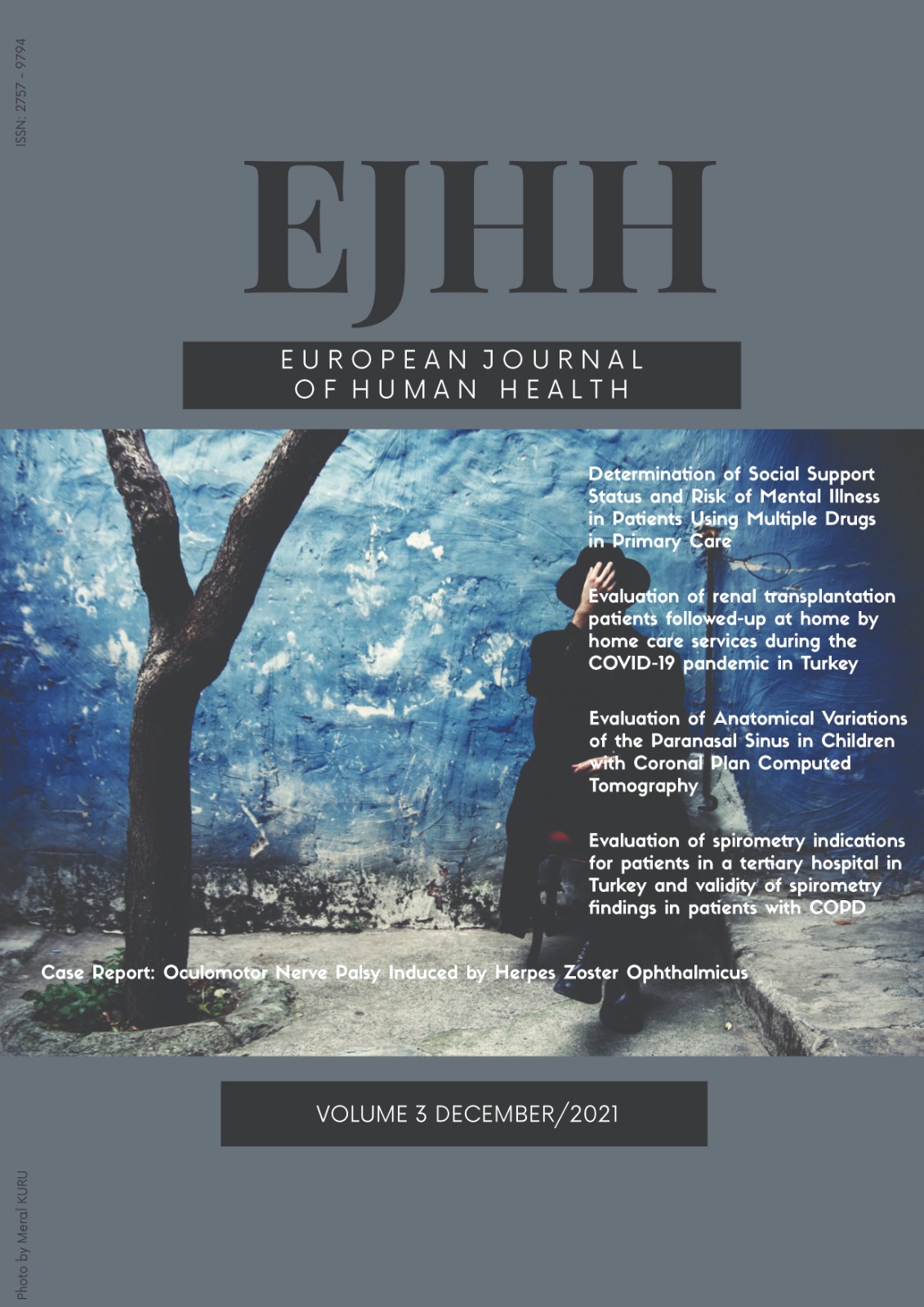Evaluation of Anatomical Variations of Paranasal Sinuses in Children with Coronal Plan Computed Tomography
Author :
Abstract
Keywords
Abstract
Aim: In this study, we aimed to evaluate the frequency of the most common anatomical variations of the paranasal sinuses and lateral nasal wall in coronal sinus CT scans of pediatric cases.
Methods: Paranasal sinus CT scans of a total of 200 pediatric patients who underwent paranasal sinus coronal CT between December 2000 and June 2005 in the Department of Radiology, Faculty of Medicine, Harran University were evaluated retrospectively. Out of 200 patients, 71 patients with pansinusitis, trauma and nasal polyposis were excluded from the study and 129 patients were included in the study.
Results: In our cases, the anatomical variation rates in the bone structure detected by CT in order of frequency were: septal deviation 72.9%, concha bullosa 60.5%, Agger nazi cell 45.8%, paradox middle turbinate 31.7%, pneumotized superior turbinate 26.4%, Haller cell 24.1%, maxillary sinus hypoplasia 23.3%, pneumotized uncinate prominence (UP) 21%, pterygoid recess pneumotization 20.2%, supraorbital ethmoid cell 17.1%, maxillary sinus septation 14%, uncinate process atelectasis 12.5%, Onodi cell 11.6%, paradoxical superior turbinate 10.9%, anterior clinoid pneumotization 9.3%, ethmomaxillary sinus 7.8% and pneumotized inferior turbinate 1.6%. Maxillary sinus hypoplasia existed in all cases with UP atelectasis. We detected decreased ipsilateral maxillary sinus volume in all but one of our ethmomaxillary sinus cases. At the same time, we observed the ipsilateral superior meatus to be wider than normal in these cases.
Conclusions: There was no significant difference between the rates of anatomical variation in bone structure in pediatric cases that we evaluated compared to the rates of anatomical variation reported in the literature for both pediatric and adult groups.
Keywords
- 1. Sivaslı E, Şirikçi A, Bayazýt Y, Gümüsburun E,Erbagci H, Bayram M, et al. Anatomic variations of theparanasal sinus area in pediatric patients with chronicsinusitis. Surgical and Radiologic Anatomy. 2002;24(6):399-404.
- 2. Cohen O, Adi M, Shapira-Galitz Y, Halperin D,Warman M. Anatomic variations of the paranasalsinuses in the general pediatric population. Rhinology. 2019;57(3):206-12.
- 3. Palabiyik F. Imaging of the anatomic variations anddangerous areas of the paranasal sinuses and nasalcavity in pediatric patients. İstanbul Kanuni Sultan Süleyman Tıp Dergisi. 2018;10(1):36-42.
- 4. Diament MJ. The diagnosis of sinusitis in infants andchildren: x-ray, computed tomography, and magneticresonance imaging: diagnostic imaging of pediatricsinusitis. Journal of allergy and clinical immunology.5. Milczuk HA, Dalley RW, Wessbacher FW, RichardsonMA. Nasal and paranasal sinus anomalies in childrenwith chronic sinusitis. The Laryngoscope.6. Lusk RP, McAlister B, el Fouley A. Anatomicvariation in pediatric chronic sinusitis: a CT study.Otolaryngologic Clinics of North America.7. McAlister WH, Lusk R, Muntz H. Comparison of plainradiographs and coronal CT scans in infants andchildren with recurrent sinusitis. American Journal of Roentgenology. 1989;153(6):1259- 64.
- 8. Hill M, Bhattacharyya N, Hall TR, Lufkin R, ShapiroNL. Incidental paranasal sinus imaging abnormalitiesand the normal Lund score in children.Otolaryngology—Head and Neck Surgery.9. Yücel A, Dereköy FS, Yılmaz MD, Altuntaş A.Sinonazal anatomik varyasyonların paranazal sinüsenfeksiyonlarına etkisi. Kocatepe Tıp Dergisi. 2004;5(1).
- 10. Stammberger H, Posawetz W. Functionalendoscopic sinus surgery. European Archives of Oto- rhino-laryngology. 1990;247(2):63-76.
- 11. Dasar U, Gokce E. Evaluation of variations insinonasal region with computed tomography. World journal of radiology. 2016;8(1):98.
- 12. Bolger WE, Parsons DS, Butzin CA. Paranasal sinusbony anatomic variations and mucosal abnormalities:CT analysis for endoscopic sinus surgery. The Laryngoscope. 1991;101(1):56-64
- 13. Smith KD, Edwards PC, Saini TS, Norton NS. Theprevalence of concha bullosa and nasal septaldeviation and their relationship to maxillary sinusitis byvolumetric tomography. International journal of dentistry. 2010.
- 14. April MM, Zinreich SJ, Baroody FM, Naclerio RM.Coronal CT scan abnormalities in children with chronic sinusitis. The Laryngoscope. 1993;103(9):985-90.
- 15. Aydın Ö, Üstündağ E, İşeri M, et al.: Pediatriksinüzitlerde paranazal sinüs anatomik varyasyonları. KBB Postası, 2000:10, 9-14.
- 16. Papadopoulou A-M, Chrysikos D, Samolis A,Tsakotos G, Troupis T. Anatomical Variations of theNasal Cavities and Paranasal Sinuses: A Systematic Review. Cureus. 2021;13(1).
- 17. Shpilberg KA, Daniel SC, Doshi AH, Lawson W,Som PM. CT of anatomic variants of the paranasalsinuses and nasal cavity: poor correlation withradiologically significant rhinosinusitis but importancein surgical planning. American Journal of Roentgenology. 2015;204(6):1255-60.
- 20. Rao VM, El-Noueam KI. Sinonasalimaging:anatomyandpathology. RadiologicClinics of North America. 1998;36(5):921-39.
- 21. Laine F, Smoker W. The ostiomeatal unit andendoscopic surgery: anatomy, variations, and imagingfindings in inflammatory diseases. AJR American journal of roentgenology. 1992;159(4):849- 57.
- 22. Arslan H, Aydınlıoğlu A, Bozkurt M, Egeli E.Anatomic variations of the paranasal sinuses: CTexamination for endoscopic sinus surgery. Auris Nasus Larynx. 1999;26(1):39-48.
- 23. Sirikci A, Bayazit Y, Bayram M. Posterior etmoidalhücrelerin özel bir varyasyonu: etmomaksiller sinüs. Tanısal ve Girişimsel Radyoloji. 2000;6:299-302.
- 24. Mafee MF. Preoperative imaging anatomy of nasal-ethmoid complex for functional endoscopic sinussurgery. Radiologic Clinics of North America. 1993;31(1):1-20
- 25.Şirikci A, Bayazıt Y, and Bayram M: Paranazal sinüsBT'lerinde izlenen anatomik varyasyonların endoskopiksinüs cerrahisi sırasında ortaya çıkabilecekkomplikasyonlar açısından değerlendirilmesi. Tanısal ve Girişimsel Radyoloji, 2000:6, 21-25.
- 26. Şirikci A, Bayazıt Y, Bayram M, Mumbuc S, GüngörK, Kanlıkama M. Variations of sphenoid and relatedstructures. European radiology. 2000;10(5):844-8.





